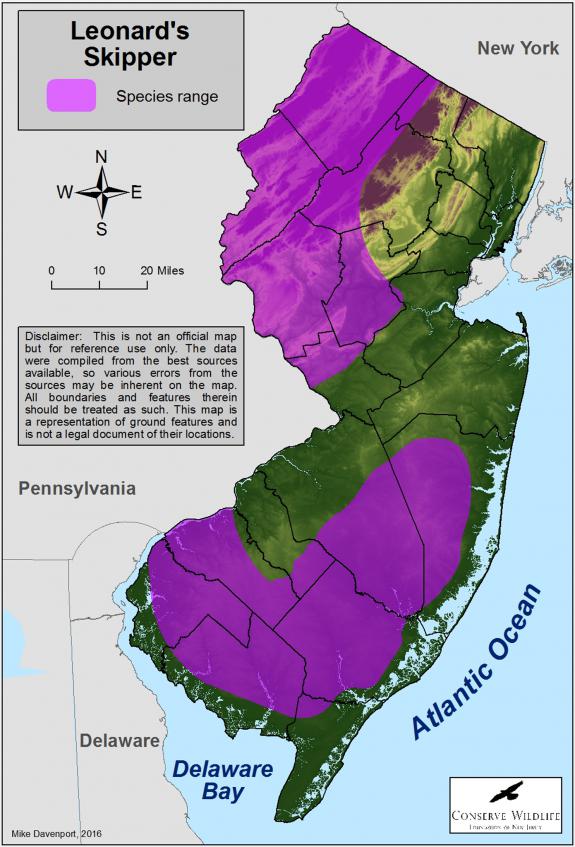Hesperia leonardus
Type: invertebrate
Status: special concern
Species Guide
Leonard's skipper
Hesperia leonardus
Species Type: invertebrate
Conservation Status: special concern
IDENTIFICATION
The Leonard’s skipper is considerably small with a wingspan of approximately 1 ¼ inches. Their upperside is red-orange in color line with wide black borders. The underside of the hindwing is brick red with a band of white spots. The Leonard’s skipper has a bold pattern on the underwing that makes them easy to distinguish from other similar skippers. The larvae of the Leonard’s skipper range in color from light brown to pale green. They are covered with short, black hairs and their head is dark brown with white V-shaped marks on the side.

Distribution & Habitat
Leonard’s skippers are found in much of the eastern and central United States and can also be found in southern Canada. This species prefers savannas, open woodlands and other dry, grassy habitats. They are seen breeding and feeding along openings in dry oak woods and pine barrens, along edges of airport grasslands, dry meadows, and native sand plains. In New Jersey, most adults are found along oak woodlands and particularly like to perch on oaks.
Diet
Adults feed on flower nectar from various species including blazing star, thistle, and aster. They are documented to have a preference for pink and purple flowers. Leonard’s skipper larvae are found on a wide range of perennial grasses including switch grass, poverty grass, and bents.
Life Cycle
Males of this species perch near food plants to look for females. The eggs are laid singly on or near host grasses and hatch within 15-20 days. The larvae feed on leaves of the host plant. They build tube-like structures to live and hibernate in. These structures are made out of rolled leaves and are lined with silk. When not feeding on leaves, they retreat to these structures for protection. After a period of hibernation, the butterflies emerge and the spring cycle will begin all over again.
Current Threats, Status, and Conservation
In New Jersey, the Leonard’s skipper is considered a species of Special Concern. They are considered secure in much of their range which is why they are not listed on a federal level. The primary threat to this species is habitat loss. In the eastern-most portion of their range, development and succession have contributed to a decline in Leonard’s skipper populations. In much of the northeast, many butterfly species that favor open, dry, grassy habitats are quickly declining.
In 2015, the New Jersey Endangered and Nongame Advisory Committee recommended changing this species’ status from Special Concern to Threatened within the state, but no formal rule proposal has been filed to date.
HOW TO HELP
The Endangered and Nongame Species Program would like for individuals to report their sightings of Leonard’s skippers. Record the date, time, location, and condition of the animal and submit the information by submitting a Sighting Report Form. The information will be entered into the state’s natural heritage program, commonly referred to as Biotics. Biologists map the sighting and the resulting maps “allow state, county, municipal, and private agencies to identify important wildlife habitats and protect them in a variety of ways. This information is used to regulate land-use within the state and assists in preserving endangered and threatened species habitat remaining in New Jersey.”
References
Text written by Emily Heiser in 2011 and updated by Mike Davenport in 2016.
Scientific Classification
- Kingdom: Animalia
- Phylum: Arthropoda
- Class: Insecta
- Order: Lepidoptera
- Family: Hesperiidae
- Genus: Hesperia
- Species: H. leonardus